
Mr. Sato attempts to eat this traditional Japanese sweet for the first time and realizes that it’s not for novices.
The man, the myth, the legend. From tackling giant versions of small foods to scoring the newest iPhone version in mediocre cosplay, there’s no other reporter willing to put his shame name on the line for the sake of quality news coverage than SoraNews24’s very own Mr. Sato.
After recently recovering from the loss of one of his favorite clothing chains in Japan, Mr. Sato decided to cheer himself up by making his annual trip to the Tori no Ichi (Rooster Market). Held over four days every year at Hanazono Shrine in Tokyo’s Shinjuku neighborhood (just a short walk from SoraNews24 headquarters), this year the Tori no Ichi festival is being held on is held on November 7, 8, 19, and 20, and Mr. Sato was just in time to visit on the first date.
▼ Morning visitors at Hanazono Shrine’s Tori no Ichi
Since Hanazono Shrine is in the vicinity of Kabuki-cho and a host of other late-night eating and drinking establishments, throngs of Shinjuku workers descend upon the market after work. Sometimes the grounds become crowded to the point that it’s hard to move around. Daytime is definitely the best time to visit if you want to take your time at a leisurely pace, which is exactly the kind of the mood that Mr. Sato was in this particular day. He decided to stroll through the market grounds on his way to work in the morning.
▼ These lanterns bearing sponsors’ names would be illuminated at night.
There’s really only one shopping item for sale at Tori no Ichi: decorative kumade rakes, made by clustering numerous good-luck symbols together in order to to boost your fortune in business. Having come early in the morning, Mr. Sato was able to quickly buy one without the usual hassle of waiting in a long line, but soon one of the food stalls caught his eye. According to the colorful banner, it was selling anzu-ame (あんず飴), literally “apricot candy,” a popular festival sweet in Japan.
He’d heard of anzu-ame before, but no festival stalls had ever sold it in the countryside of Shimane Prefecture where he grew up as a country bumpkin. He’d had a similar-sounding apple candy, but never anything with apricot before. He abruptly decided that this year would be the year to fix this deprivation of his childhood. As he made his way over to the booth, little did he know that the following chain of events would test the very limits of his grown-up ability to buy and eat food on his own.
First, it turned out that the act of purchasing anzu-ame wasn’t as straightforward as it seemed. Anzu-ame was listed as 200 yen (US$1.85) on the stall’s sign, so he pulled out a couple of coins and ordered–at which point the shopkeeper replied, “How many would you like?”
…Huh? What else was there to choose? One serving of anzu-ame is one, right? This system didn’t make any sense!
Confused, Mr. Sato truthfully told the lady that this was his very first time ordering anzu-ame and he didn’t know what she was asking. She said that he could choose one type of fruit from among all of the prepared offerings such as mikan [mandarin orange] and strawberry. It then dawned on him that even though this was technically APRICOT candy, there were more choices than simply apricot. He was a bit miffed at whoever had given it this name. Furthermore, since it was still early and the booth was still in the midst of prep-work, apricot wouldn’t even be a an option until later in the day. There wasn’t anything Mr. Sato could do in the meantime so he asked for the mikan.
Next, while the shopkeeper was preparing his food, she suddenly declared, “Give that thing a whirl.” “That thing”? He looked down and to his surprise, there was a small rotatable container on the counter, and when you turned it over, a single marble would fall out, with a special color winning you a prize.
That’s when he finally realized that the price tag for anzu-ame included a small note that read “Price of one game included.” So THAT’s what that meant! He was then told that if he won the game he could get one more type of fruit for free. Seriously? Why, anzu-ame, why!? Your name is misleading and your order system is so confusing that only experts can order you unscathed!
He unfortunately didn’t win the game, but in any case his food was ready after a short time. A slice of mikan orange was encased delicately inside of a mizu-ame (sweet starch syrup) topping. A thin pick-like utensil also lay alongside it. The lady helpfully provided him with a tip for eating–“Please eat it with that wafer shell (the ‘cup’). If you try biting into it the syrup will stick to your teeth, so it’s better to gradually lick it.”
▼ Finally, here it was–his very first anzu-ame!
When the lady had handed it over to him, she had also said the following: “Normally I leave some ice on that tray over there and you eat it after the syrup chills for a bit, but I haven’t gotten a chance to prepare the ice yet today.” As someone who was eating this for the very first time, her words didn’t make much sense to him. He wouldn’t grasp the full meaning until a little bit later…
Now for the moment of truth. Mr. Sato plopped his things down near the edge of the staircase on the shrine grounds and balanced the wafer cup on his thigh. He felt a fun sense of excitement about trying a traditional sweet for the first time and took more photos than usual while taking care not to knock it over.
▼ The way the syrup glinted in the light was actually quite pretty.
Actually, he should’ve taken a bite sooner because while he was goofing around with photos, bits of the mikan orange had dissolved into the syrup, leaving thin threads of orange swirled throughout:
“Huh? What’s going on? How am I supposed to eat the fruit now?” he thought. Maybe what the lady had been saying earlier about chilling it in ice was in order to avoid this exact sticky situation. The words “It’s better to gradually lick it” echoed in his mind…but he still felt like he was missing something.
It was worth a try, so he licked the syrup. It wasn’t easy to do and stuck to his lips. That was probably wrong, right? But then what was actually right? Is it possible to actually fail at eating something??
But even among Japanese people who eat it every chance, anzu-ame is recognized as a very messy, sticky snack. Mr. Sato wasn’t doing anything wrong, he just lacks experience. Lucky for him, this was just the first of four Tori no Ichi days, so he’s got plenty of opportunities to go back and eat more desserts, all in the name of making himself a more educated, well-rounded member of Japanese society.
Shrine information
Hanazono Jinja / 花園神社
Address: Tokyo-to, Shinjuku-ku, Shinjuku 5-17-3
東京都新宿区新宿5-17-3
Website
Photos © SoraNews24
● Want to hear about SoraNews24’s latest articles as soon as they’re published? Follow us on Facebook and Twitter!
[ Read in Japanese ]

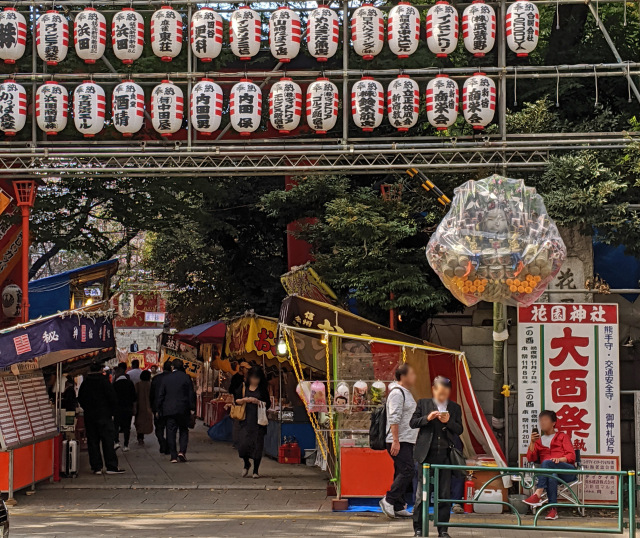
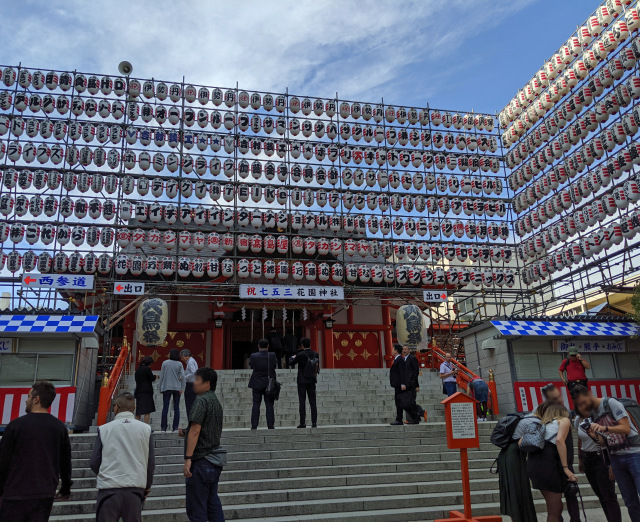
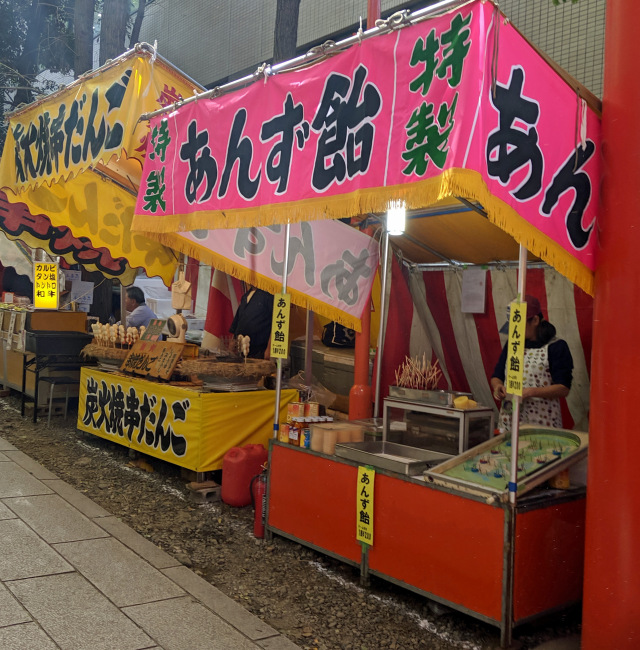
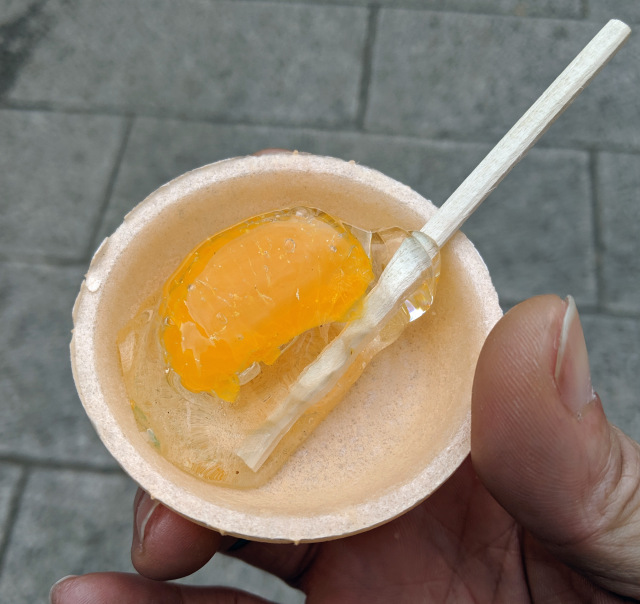
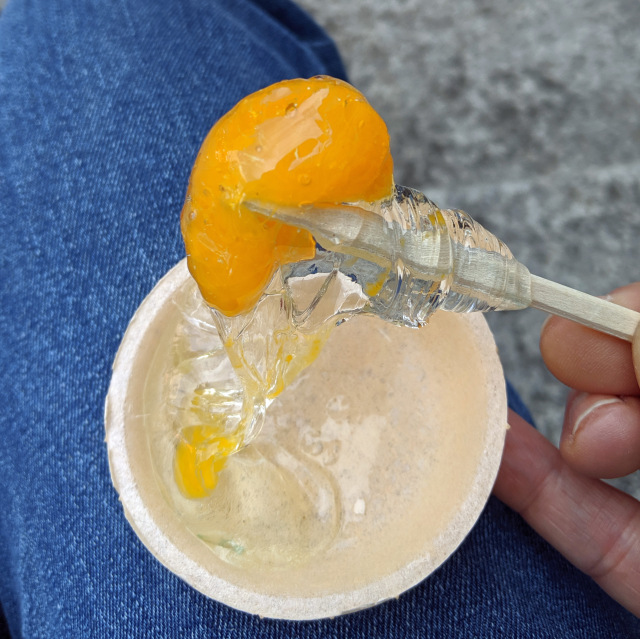
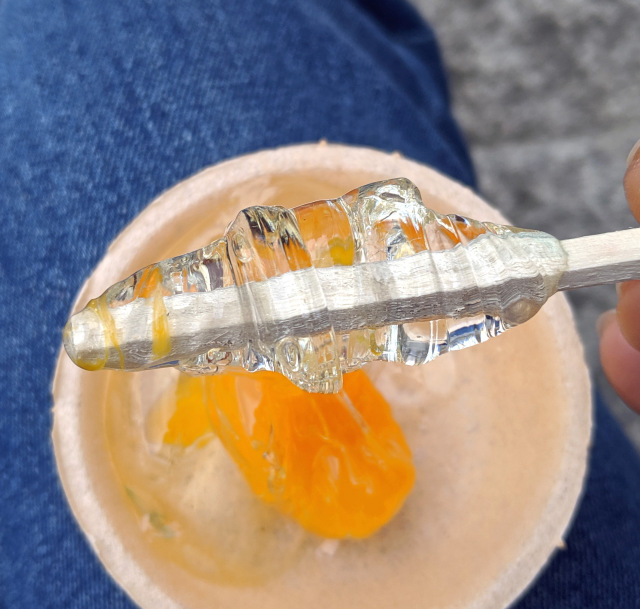

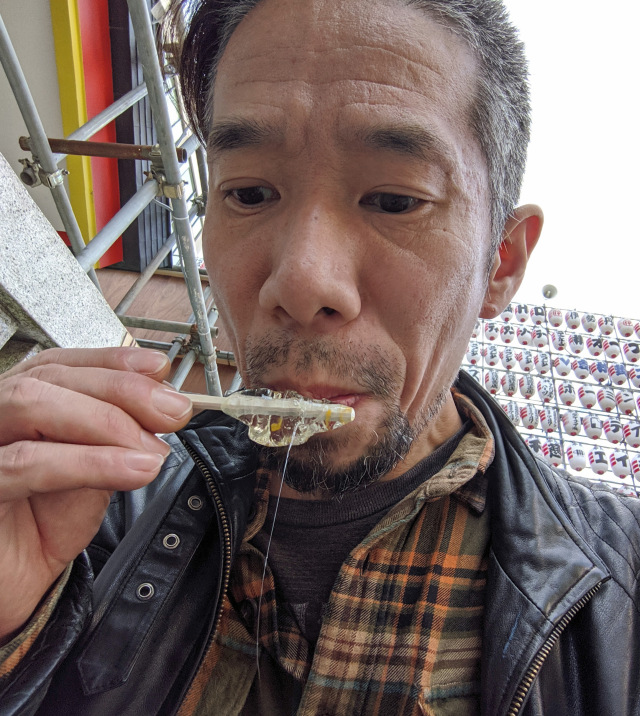
 Hanazono Jinja Shrine: Lanterns, stalls and rakes at annual Tori no Ichi cock festival in Tokyo
Hanazono Jinja Shrine: Lanterns, stalls and rakes at annual Tori no Ichi cock festival in Tokyo Futuristic drinks stand in Tokyo lets you order cute, personalised beverages from your phone
Futuristic drinks stand in Tokyo lets you order cute, personalised beverages from your phone Mr. Sato attempts to conquer mountains of shaved ice at all-you-can-eat event
Mr. Sato attempts to conquer mountains of shaved ice at all-you-can-eat event Japanese cafe tops its shaved ice with fire for an impossibly delicious treat【Video】
Japanese cafe tops its shaved ice with fire for an impossibly delicious treat【Video】 We sample blue Drift Ice Curry from the India of the Okhotsk Sea
We sample blue Drift Ice Curry from the India of the Okhotsk Sea Red light district sushi restaurant in Tokyo shows us just how wrong we were about it
Red light district sushi restaurant in Tokyo shows us just how wrong we were about it Sandwiches fit for a sumo served up in Osaka【Taste Test】
Sandwiches fit for a sumo served up in Osaka【Taste Test】 McDonald’s new Happy Meals offer up cute and practical Sanrio lifestyle goods
McDonald’s new Happy Meals offer up cute and practical Sanrio lifestyle goods Japanese ramen restaurants under pressure from new yen banknotes
Japanese ramen restaurants under pressure from new yen banknotes Pokémon Sleep camping suite and guestrooms coming to Tokyo Hyatt along with giant Snorlax burgers
Pokémon Sleep camping suite and guestrooms coming to Tokyo Hyatt along with giant Snorlax burgers Starbucks Japan adds a Motto Frappuccino to the menu for a limited time
Starbucks Japan adds a Motto Frappuccino to the menu for a limited time Beautiful Red and Blue Star luxury trains set to be Japan’s new Hokkaido travel stars
Beautiful Red and Blue Star luxury trains set to be Japan’s new Hokkaido travel stars Tokyo Tsukiji fish market site to be redeveloped with 50,000-seat stadium, hotel, shopping center
Tokyo Tsukiji fish market site to be redeveloped with 50,000-seat stadium, hotel, shopping center Mt. Koya planning to instate visitor’s tax to cope with huge tourist numbers
Mt. Koya planning to instate visitor’s tax to cope with huge tourist numbers Anime girl English teacher Ellen-sensei becomes VTuber/VVTUber and NFT
Anime girl English teacher Ellen-sensei becomes VTuber/VVTUber and NFT All-you-can-drink Starbucks and amazing views part of Tokyo’s new 170 meter-high sky lounge
All-you-can-drink Starbucks and amazing views part of Tokyo’s new 170 meter-high sky lounge More foreign tourists than ever before in history visited Japan last month
More foreign tourists than ever before in history visited Japan last month French Fries Bread in Tokyo’s Shibuya becomes a hit on social media
French Fries Bread in Tokyo’s Shibuya becomes a hit on social media Studio Ghibli releases new action figures featuring Nausicaä of the Valley of the Wind characters
Studio Ghibli releases new action figures featuring Nausicaä of the Valley of the Wind characters New private rooms on Tokaido Shinkansen change the way we travel from Tokyo to Kyoto
New private rooms on Tokaido Shinkansen change the way we travel from Tokyo to Kyoto Starbucks reopens at Shibuya Scramble Crossing with new look and design concept
Starbucks reopens at Shibuya Scramble Crossing with new look and design concept Studio Ghibli glasses cases let anime characters keep an eye on your spectacles
Studio Ghibli glasses cases let anime characters keep an eye on your spectacles Beautiful Ghibli sealing wax kits let you create accessories and elegant letter decorations【Pics】
Beautiful Ghibli sealing wax kits let you create accessories and elegant letter decorations【Pics】 Studio Ghibli releases Kiki’s Delivery Service chocolate cake pouches in Japan
Studio Ghibli releases Kiki’s Delivery Service chocolate cake pouches in Japan New definition of “Japanese whiskey” goes into effect to prevent fakes from fooling overseas buyers
New definition of “Japanese whiskey” goes into effect to prevent fakes from fooling overseas buyers Our Japanese reporter visits Costco in the U.S., finds super American and very Japanese things
Our Japanese reporter visits Costco in the U.S., finds super American and very Japanese things Studio Ghibli unveils Mother’s Day gift set that captures the love in My Neighbour Totoro
Studio Ghibli unveils Mother’s Day gift set that captures the love in My Neighbour Totoro New Japanese KitKat flavour stars Sanrio characters, including Hello Kitty
New Japanese KitKat flavour stars Sanrio characters, including Hello Kitty New Pokémon cakes let you eat your way through Pikachu and all the Eevee evolutions
New Pokémon cakes let you eat your way through Pikachu and all the Eevee evolutions Disney princesses get official manga makeovers for Manga Princess Cafe opening in Tokyo
Disney princesses get official manga makeovers for Manga Princess Cafe opening in Tokyo Sales of Japan’s most convenient train ticket/shopping payment cards suspended indefinitely
Sales of Japan’s most convenient train ticket/shopping payment cards suspended indefinitely Sold-out Studio Ghibli desktop humidifiers are back so Totoro can help you through the dry season
Sold-out Studio Ghibli desktop humidifiers are back so Totoro can help you through the dry season Japanese government to make first change to romanization spelling rules since the 1950s
Japanese government to make first change to romanization spelling rules since the 1950s Ghibli founders Toshio Suzuki and Hayao Miyazaki contribute to Japanese whisky Totoro label design
Ghibli founders Toshio Suzuki and Hayao Miyazaki contribute to Japanese whisky Totoro label design Doraemon found buried at sea as scene from 1993 anime becomes real life【Photos】
Doraemon found buried at sea as scene from 1993 anime becomes real life【Photos】 Tokyo’s most famous Starbucks is closed
Tokyo’s most famous Starbucks is closed One Piece characters’ nationalities revealed, but fans have mixed opinions
One Piece characters’ nationalities revealed, but fans have mixed opinions We asked a Uniqlo employee what four things we should buy and their suggestions didn’t disappoint
We asked a Uniqlo employee what four things we should buy and their suggestions didn’t disappoint Princesses, fruits, and blacksmiths: Study reveals the 30 most unusual family names in Japan
Princesses, fruits, and blacksmiths: Study reveals the 30 most unusual family names in Japan Is it possible to make a cheap senbero drinking party with your dog? 【Japan’s Best Home Senbero】
Is it possible to make a cheap senbero drinking party with your dog? 【Japan’s Best Home Senbero】 Tokyo’s spicy cod roe ice cream: An unexpected dessert that tastes about like what you’d expect
Tokyo’s spicy cod roe ice cream: An unexpected dessert that tastes about like what you’d expect Mos Burger’s new French toast: A delicious breakfast with a side of linguistic challenges
Mos Burger’s new French toast: A delicious breakfast with a side of linguistic challenges Could you eat 50 beef cutlet refill pieces? If so, this Japanese restaurant will let you eat for free
Could you eat 50 beef cutlet refill pieces? If so, this Japanese restaurant will let you eat for free Frozen pudding pops among the many surprises at Ramen Deniro in Tokyo
Frozen pudding pops among the many surprises at Ramen Deniro in Tokyo Is that restaurant in Tokyo with the giant mecha crab sign any good?
Is that restaurant in Tokyo with the giant mecha crab sign any good? Choux pastry mania: Mr. Sato tries Beard Papa’s new Japanese-style cream puffs 【Taste Test】
Choux pastry mania: Mr. Sato tries Beard Papa’s new Japanese-style cream puffs 【Taste Test】 We eat a luxurious Japanese-style buffet breakfast in a restaurant full of wood-carved bears
We eat a luxurious Japanese-style buffet breakfast in a restaurant full of wood-carved bears Can a plant-based restaurant serving Buddhist meals turn meat-loving Mr. Sato into a vegetarian?
Can a plant-based restaurant serving Buddhist meals turn meat-loving Mr. Sato into a vegetarian? Tokyo’s new burger chain isn’t new, is disappointing, tasty, and hopeful all at once【Taste test】
Tokyo’s new burger chain isn’t new, is disappointing, tasty, and hopeful all at once【Taste test】 Mr. Sato stuffs himself at an all-you-can-eat bakery event and ascends to carb heaven【Pics】
Mr. Sato stuffs himself at an all-you-can-eat bakery event and ascends to carb heaven【Pics】 Douhua, a delicious tofu pudding, is Mr. Sato’s new favourite food
Douhua, a delicious tofu pudding, is Mr. Sato’s new favourite food Japanese chain Bikkuri Donkey’s enormous salad almost beats Mr. Sato, but not because of its size
Japanese chain Bikkuri Donkey’s enormous salad almost beats Mr. Sato, but not because of its size We eat tasty egg sandwiches from Japan’s first branch of Eggslut, the U.S.-based breakfast shop
We eat tasty egg sandwiches from Japan’s first branch of Eggslut, the U.S.-based breakfast shop We try french fries and chocolate sauce at Lotteria Japan
We try french fries and chocolate sauce at Lotteria Japan
Leave a Reply